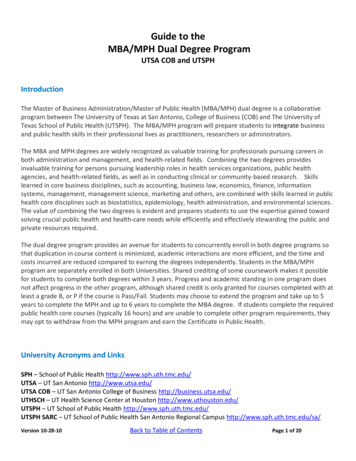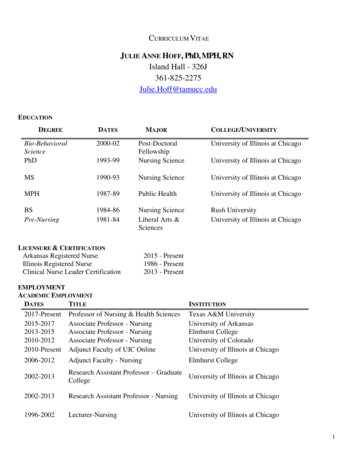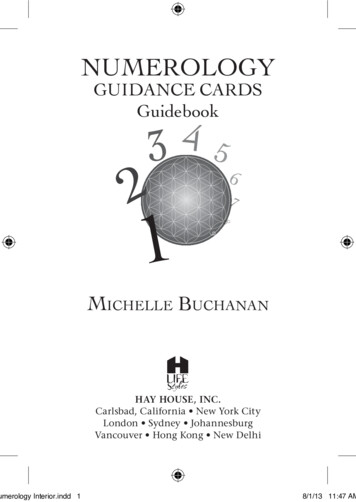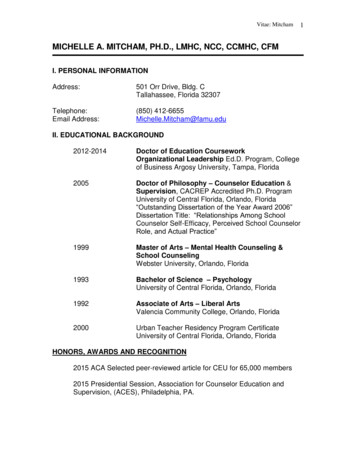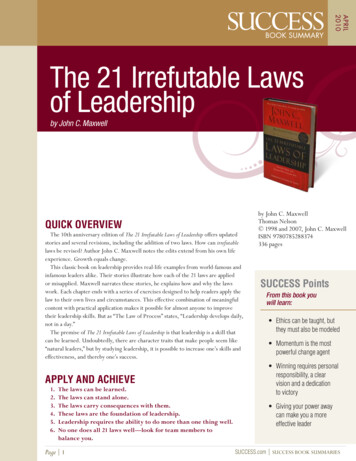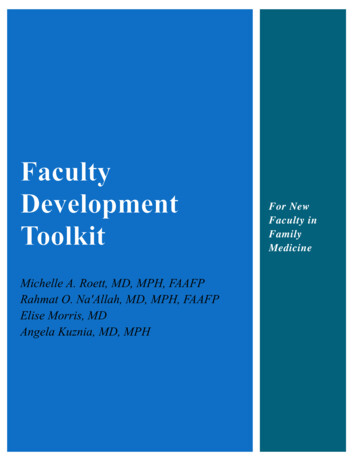
Transcription
For NewFaculty inFamilyMedicineMichelle A. Roett, MD, MPH, FAAFPRahmat O. Na'Allah, MD, MPH, FAAFPElise Morris, MDAngela Kuznia, MD, MPH0
Table of ContentsPresentation Slides . 2First Year on the Job ABCDDs . 26Assessing skills . 27Balance . 27Credentialing . 28Determining focus areas . 28Department infrastructure . 29Faculty development . 30Institutional opportunities for faculty development: . 30Fellowship opportunities. 30Teaching, Precepting and Curricular Development resources . 30Grant-writing resources . 31Family Medicine Conferences . 31Academic Family Medicine conferences . 31CME conferences . 31Academic conferences . 31Diagnostic and therapeutic procedure skills training. 31Maternity care skills training . 31Leadership Development . 32Scholarly Activity . 33Educator portfolio. 33Explore local, regional and national opportunities . 33Scholarly activity requirements . 33Generate scholarly activity. 33Grant applications. 33Sample Educator Portfolio . 34Keeping Up-To-Date as a Faculty Member . 42New Faculty Brochure .51Miscellaneous Resources . 53Notes. 54References. 551
Presentation Slides2
3
4
5
6
7
8
9
10
11
12
13
14
15
16
17
18
19
20
21
22
23
24
25
First Year on the Job ABCDDsAssessing skills BSelf-assessmentResident and student evaluationsFaculty peer evaluationsFPPE/OPPE evaluation processalance For NewFaculty inFamilyMedicinePersonal goalsSetting boundariesTime managementCredentialing Maintaining licensureCME requirements for institution and state licensing boardsDetermining focus areas Medical Student educationResidency educationResearchDepartment infrastructure DivisionsTeaching opportunitiesCollaborative partners26
Assessing skills1. Self-assessment:University departments will often have a self-assessment tool to perform a self-evaluationincluding estimating percentage of time dedicated to each teaching realm and summarizeevaluations.Suggested competencies: ACGME Milestones Leadership Administration Teaching Curricular Development Research Medical Informatics Care management Multi-culturalismRecommended tools: Family Medicine Milestone self-assessment2. Student and resident evaluations.The evaluation of faculty teaching performance is complex. Most academic medical centers usethe open evaluation format. Anonymous evaluation is more accurate reflection of teachingperformance.13. Faculty peer evaluationsInstitutional tools available for peer evaluations, but often limited in both frequency of use andcompetencies assessed. Request that faculty peers sit in on lectures/workshops Consider asking division director to sit in on lectures/workshops Record all peer evaluations in portfolio4. FPPE/OPPE or faculty competency evaluations Hospital affiliated divisions will have a Joint Commission requirement for FocusedProfessional Performance Evaluation and Ongoing Professional Performance Evaluation OPPE: annually administered by most departments FPPE: typically more frequently in first 3-6 months of employment, or after specificconcern raised.Balance1. Personal goals Personal and professional goalso Planning vacation, down-time, self-renewal, mind-body wellnesso Setting a timeline for the academic year for specific professional goals, e.g. facultydevelopment activities, attending STFM conference to see examples of curricula intopic area Short-term and long-term goalso Collaborate with division director/department chair in goal-settingo 6-, 9-, 12- month short term goals, such as learning about each division, observingteaching venues, delivering lectures.27
o Think about 2-5 year faculty development plan, e.g. presenting a topic at a nationalconference in 2-3 years, publishing a review article with senior faculty in 2-3 years,applying for Assistant or Associate Professor faculty rank Experience in focus areaso Curricular development (RCR, FMDRL, MedEdPortal)2. Setting boundaries Learning to say no Accepting assignments from an outgoing faculty member Aligning personal interests with mission of the department or division3. Time management Percentage administrative time, using demonstrated models Setting calendar time helps avoid encroachmento Weekly calendar should reflect dedicated time to specific activities e.g. curriculardevelopment, planning lectures, evaluating residents, EMR documentationo Consider quarterly reminders about faculty development applications, grantopportunities or conferences4. Burnout prevention resourcesCredentialing1. Maintaining licensure Each state licensing board has different renewal requirements, dates, etc. Note expiration dates, licensing numbers (license, CDS, DEA), renewal requirements2. CME requirements State licensing boards and hospital credentialing departments have CME requirements peryear or per renewal period. Log and update CME transcript continuously with free CME reporting service athttp://www.aafp.org/cme Log teaching CME credits (up to 20 elective credits per cycle) Consider planning CME around academic focus areas. Plan for year’s CME, local AAFPchapter, online CME with AFP Journal, etc. CME resources with AAFPo American Family Physician (24 free CME quizzes up to 90 AAFP Prescribed credits)o Family Practice Management (6 free quizzes up to 20 AAFP prescribed credits)o 1280 Board Review sample questions with up to 32 AAFP Prescribed creditso AAFP online self-study activities up to 38.5 AAFP Prescribed creditsDetermining focus areas1. Focus areas in faculty positions often aligned with division hired into Residency Medical Student Education Research2. Focus areas may be contract defined. Otherwise, defining clinical percentage may help determinepercentages of other activities.228
ClinicDirectorDirector ofEducationDirector ofMedicalStudentEducationClerkshipDirectorDirector pAdministrationTeachingCurriculum 0351001010104020051005755102510540Faculty Competency ingCurricular Development STFM/AFMRD RCR FMDRL MedEdPortalResearchMedical InformaticsCare managementMulti-culturalismDepartment infrastructure1. Divisions2. Teaching opportunities3. Collaborative partners (interprofessional, interdisciplinary, community)29TeacherClinician
Faculty developmentInstitutional opportunities for faculty development: Family Medicine department (Residency, MSE, Research) Interdepartmental or multidisciplinary opportunities University Department of Faculty Affairs e.g. Georgetown seminarscheduleat ultydevelopment/programsandworkshopsFor NewFaculty inFamilyMedicineFellowship opportunities Family Medicine hip/Search Faculty development fellowships at specific institutions (in-person orwebinar based) STFM Medical Student Educators Director Fellowship Residency faculty development (National Institute for ProgramDirector Development) Georgetown University (Health Policy Fellowship at the RobertGraham Center, Community Health, Medical Humanities and Healthand Media). https://familymedicine.georgetown.edu/fellowships Robert Wood Johnson Foundation:http://www.rwjfleaders.org/programs Harvard Macy Institute ew.aspx Research Fellowship:o Univ of arch/training/nrsao Univ of esearch Duke Univ or Johns Hopkins: Mini Fellowship in Geriatrics (1 week) U Mass: Teaching of Tomorrow (2-day) Univ of rnet/faculty dev fm/Curriculum.cfm Univ of North Carolina:http://www.shepscenter.unc.edu/training programs/nrsapc/Teaching, Precepting and Curricular Development resources TeachingPhysician.org free webinars ingPhysicianWebinars STFM precepting resources for precepting medical students andresidents at https://www.teachingphysician.org/ Family Medicine Residency Curricular Resource for resident lectures,workshops, curricula http://fammedrcr.org/ STFM Resource Library http://fmdrl.org/30
Grant-writing resources Foundation Center courses troduction-to-proposal-writingFamily Medicine ConferencesAcademic Family Medicine conferences STFM Annual Spring ringConference STFM Conference on Medical Student eonMedicalStudentEducation STFM Conference on Practice nceonpracticeimprovement Association of Family Medicine Residency Directors www.afmrd.orgo Residency Program Solutions mlo Program Director Workshop mlFor NewFaculty inFamilyMedicineCME conferences AAFP http://www.aafp.org/events.html STFM On the Road http://www.stfm.org/Conferences/OnTheRoad Online modules: self-directed, computer-based faculty developmentcontribute to knowledge mastery and retention3Academic conferences AAMC Early Career Women Faculty Professional DevelopmentSeminar mmaryd959a1ec7b4340429f75555ae213bf93.aspx AAMC Minority Faculty Career Development Seminar AAMC Learn Serve Lead: AAMC Annual MeetingDiagnostic and therapeutic procedure skills training National Procedures Institute http://www.npinstitute.com/Maternity care skills training Family-Centered Maternity Care e.html ALSO Providerhttp://www.aafp.org/about/initiative
01.07.2010 · o 1280 Board Review sample questions with up to 32 AAFP Prescribed credits o AAFP online self-study activities up to 38.5 AAFP Prescribed credits Determining focus areas 1. Focus areas in faculty positions often aligned with division hired into Residency Medical Student Education Research 2. Focus areas may be contract defined. Otherwise, defining clinical percentage may help determine .
